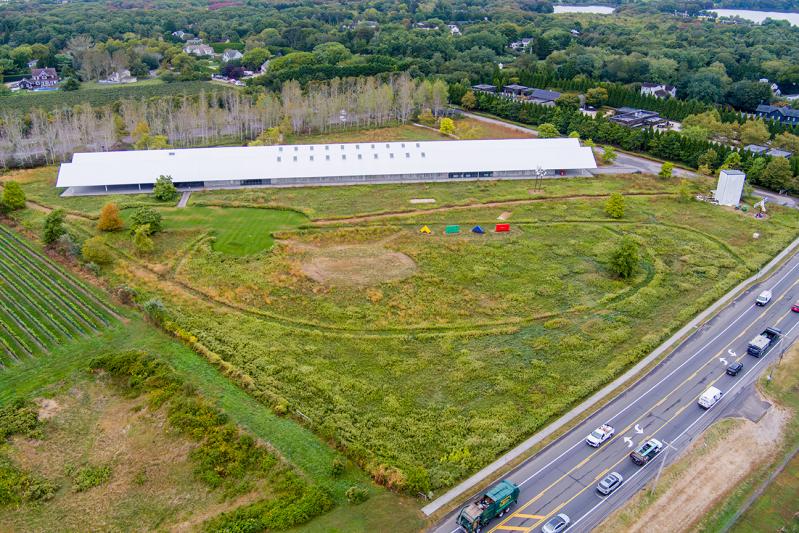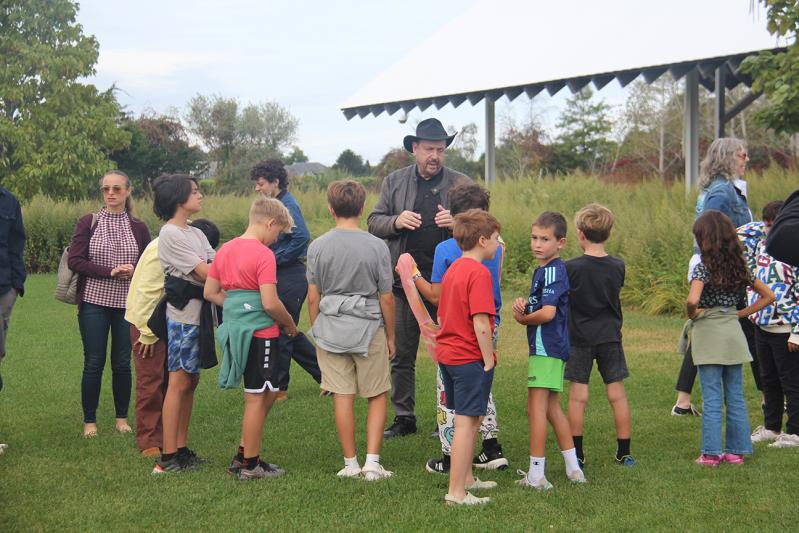Last month, Alan Sonfist, an internationally renowned environmental artist, was joined by students from Bridgehampton's Hayground School to launch his latest site-specific installation, "Celestial Meadow," on the south lawn of the Parrish Art Museum in Water Mill.
"The first phase," said Mr. Sonfist, "is to restore the land to an ecological balance so that I'm able to reintroduce ancient plants to the site. Because microbes have been altered in the site over the years, we will be introducing ancient microbes back into the soil."
To that end, the students helped to cover a portion of the meadow with an eco-friendly tarp to suppress mugwort, an invasive species introduced by Europeans during America's colonial period.
Once the area is stabilized, which is expected to take a year, holes will be cut in the tarp and seeds and young plants native to the area will be planted. "What I'm trying to do is create a dominance of ancient vegetation so they will dominate the site, as opposed to the European plants that dominate the site now."
How does he determine that ancient vegetation? For "Lost Falcon of Westphalia," a 2004 installation in Germany commissioned by Prince Richard of Westphalia, the idea was to introduce plants that were indigenous there after the Ice Age. "I worked with a plant historian, and we identified the key plants that were once there through his studies of Ice Age plant fossils. The specimens used were selected due to their ability to survive with the rising temperatures of today."
Mr. Sonfist is working with a Long Island plant historian for the Parrish project. "I have a general idea, but I want it to be based on scientific understanding of the land and how the vegetation evolved."
However, there is another dimension to "Celestial Meadow," as the name suggests. As native flora grow through the tarp and reach full bloom by summer 2026, their pattern will reflect the solar constellations above the museum grounds.
In addition, while they aren't necessarily visible to the naked eye, "Depending on how far away we are from the different stars or galaxies, they all have different colors. I'm using those colors to reflect the palette of the universe. And I'm going to push the meadow back to a post-Ice Age landscape."

"Celestial Meadow" will be part of a larger exhibition on ecology being organized by Corinne Erni, the museum's chief curator of art and education, for 2026.
"Alan came to the Parrish last year," Ms. Erni said, "and I told him I founded an organization on art and climate change 20 years ago and that I had always had a special interest in ecology. So we started talking about this project. We're in an area that is so beautiful, but nature is also threatened, and I wanted to do something that is aesthetically beautiful and that is integrated as part of the meadow and not something imposed or put on it or installed on it. There's something very scientific but also very poetic about 'Celestial Meadow.' "
When it comes to environmental or ecological art, Mr. Sonfist was not merely ahead of the curve. In 1965, there was no curve. When he proposed "Time Landscape" to the New York City Parks Department that year, to the extent there was land or environmental art, it was more likely sculptural or architectural in nature.
For "Time Landscape," sited on the northeast corner of the intersection of Houston Street and LaGuardia Place in Greenwich Village, Mr. Sonfist, after extensive research, created an indigenous forest on the site, one that, as he has written, "offers a glimpse into the 17th-century and earlier Manhattan."
"At that moment in the '60s, city planners said we don't put forests in cities. The logic was -- which is totally illogical -- that they're dangerous. That was one of the responses. The reason there's steel fence around it is that the city required it, they thought the trees were going to attack humans. I'm making that up, but anyway, they were worried. No one was doing something like that at that time."
Mr. Sonfist grew up in the Bronx near Hemlock Forest, an ancient woodland. "I used that as the underpinning for creating the forests of New York. My original vision for 'Time Landscape' was not just to create a park, but to create marshland, a river, a stream, to create a whole diversity of terrain."
Despite some resistance and skepticism, the project became very successful because "Time Landscape," which took over 10 years to create, received international coverage, and many other commissions followed, among them "Lost Falcon of Westphalia." The fact that "Time Landscape" was in such a public spot, adjacent to a Grand Union supermarket and just north of SoHo, made it all the more notable.
An earlier project, "Circles of Time," was created in 1986 in Italy. A narrative history of the Tuscan landscape, it radiates out in a series of rings from an inner core, which represents a primeval forest before human intervention. Each ring represents a different time in the environmental history of Tuscany.
The outer ring consists of contemporary agricultural uses of the land, including olives and wheat. UNESCO has selected "Circles of Time" as a Cultural Heritage Site.
More recently, Mr. Sonfist's concern about the climate crisis has led him to initiate Land Art Forward, an alliance of young artists and scientists launched last year with a symposium organized by the art, culture, and technology program at M.I.T.
Land Art Forward is evolving into a foundation that will support projects all over the world, said Mr. Sonfist. "It's not as much about me as it is about the environmental crisis going on. It's a collaboration of scientists and artists working together."
A similar symposium was held in South Korea, and discussions are underway about holding another in Shanghai. In addition, Land Art Forward will be represented in December at Art Basel in Miami Beach by the Fredric Snitzer Gallery in the Meridians sector, a platform for large-scale projects that push the boundaries of the traditional art fair.
Of phase one at the Parrish, Mr. Sonfist said, "It was a really good group of kids. I really enjoyed working with them. I think the whole staff of the museum is excellent. Everyone worked really well together."
"We didn’t think about de-installing it," Ms. Erni said when asked about the project's future. "So I can say it will be as permanent as it decides to be."




